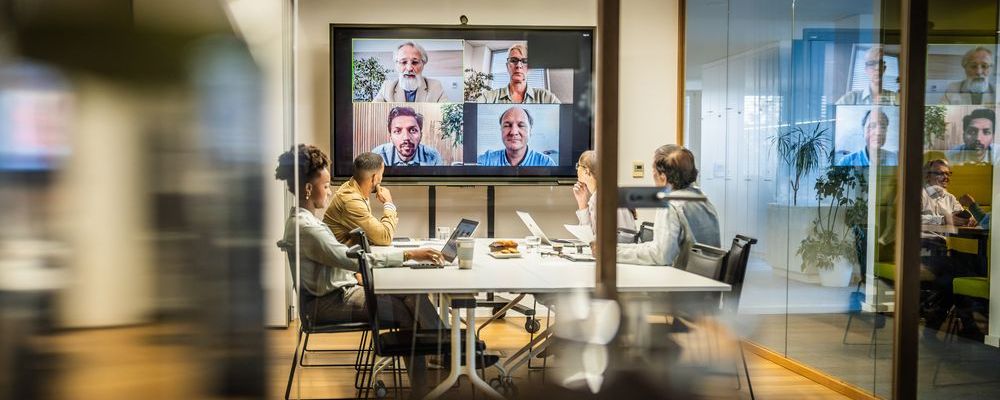Leaders and policymakers must prepare for the advent of a ‘hybrid’ workplace of blended office and home working when the world starts to emerge from the pandemic, according to two new reports.
In Finding a New Balance, published last week, collaboration technology provider Barco ClickShare reveals that 49% of staff enjoy working from home less than they did at the dawn of the crisis, while 42% complain that remote working has stifled their creativity. On average, workers want to spend a maximum of just two days per week at home once the pandemic subsides. (Barco ClickShare, 13 October 2020)
Compiled from a survey of 1,750 employees around the world – that’s 250 each from the US, UK, France, Germany, Australia, India and the UAE – the figures also show that 37% of staff are missing office social life and 29% have found it difficult to make their contributions heard in video meetings.
Similar findings have surfaced from The Future of the Office and Office Workers. Produced by the British Contract Furnishing Association (BCFA) from a mixture of polling and empirical research, the report concludes that the pre-pandemic office nine-to-five will be a thing of the past as we reach the other side of the pandemic. However, it notes, speculation around the death of the office is misplaced, and a blended model will be the way forward. (BCFA, 14 October 2020)
One significant factor that is taking the shine off remote working is stress, with staff reporting loneliness and technology problems as key drivers.
In a statement, Barco ClickShare marketing director Lieven Bertier said: “Covid-19 has meant the greatest and fastest shift in ways of working that we’ve ever seen. But while the world of work will never be the same again, the immediate reaction to the pandemic – that office life as we know it would end and people would move to universal remote working for the foreseeable future – already looks to be an overreaction.”
Meanwhile, BCFA managing director Jeremy Stein noted: “The seismic change that has happened over the past several months is here to stay – the future will be a mix of people working from home and working and collaborating at the office. This will have major implications across the country and we are urging government at all levels to take this into account as they make policy decisions for the future.”
Which key leadership and management skills will be crucial for overseeing the hybrid workforce?
The Institute of Leadership & Management’s head of research, policy and standards Kate Cooper says: “Before the pandemic struck, many firms would already have had planned-change schemes either under consideration or in the investment pipeline for the sorts of technology- and culture-based policies and procedures that would support a shift to flexible working. What happened with lockdown was that we were forced into a state of emergent change, whereby changes were unfolding in spite of some of those plans. However, now we’re entering a post-change scenario, the challenge for many organisations – as per every change initiative – is to make the new ways of working stick.”
She explains: “We have to look at drivers and deterrents: what’s making the new ways stick, and what’s making them come unstuck? With home working, it would seem that one of the main deterrents is that people need to be with, or near, their colleagues. Meanwhile, the excitement that many felt around not having to commute, and that others felt around the ability to flex their working day, has worn off. On top of that, people in many parts of the country haven’t been able to see their friends or family either. So all told, there’s a great deal of palpable, pent-up need to resume social connections. And given how big a part of life work is, it’s understandable that people are looking to their jobs to meet that need.
Cooper notes, “When we’re thinking about work styles, it’s important to remember that what’s flexible for one individual won’t be flexible for another. It’s the circumstances for the individual and their life – the demands on their time – that dictate the terms of the flexibility they need. But those terms must also be aligned with the overall performance objectives of the organisation. Colleagues will find ways to socialise, that much is evident – particularly as online connection, by itself, is increasingly seen as unfit for purpose.”
With all this in mind, she points out, the key skills for managers here are:
- a recognition of how flexibility must respond to individual needs;
- an acknowledgement of work’s critical social function, and
- an understanding that whatever change initiatives you have in place will require ongoing management and attention as time goes on.
“Keep listening to what staff say they want to see,” Cooper urges. “When we’re in the same room as other people, we pick up a lot of informal data that we process subconsciously. As it stands with our current, online arrangements, we’re hardly picking up any informal data at all. We may improve at the process, but at the moment, we’re not getting a lot of those nuanced cues and insights that we often glean in person about how people are feeling on various job-related subjects.”
She adds: “As we’re hearing, what so many workers are missing right now is fun: the joy of being with colleagues who have a shared sense of meaning and purpose in their tasks, and want to deliver something collaboratively and collectively. So there’s a big challenge for leaders with replicating that sort of camaraderie online.”
For further insights on the themes raised in this blog, check out the Institute’s resources on leading change.
Source refs:

